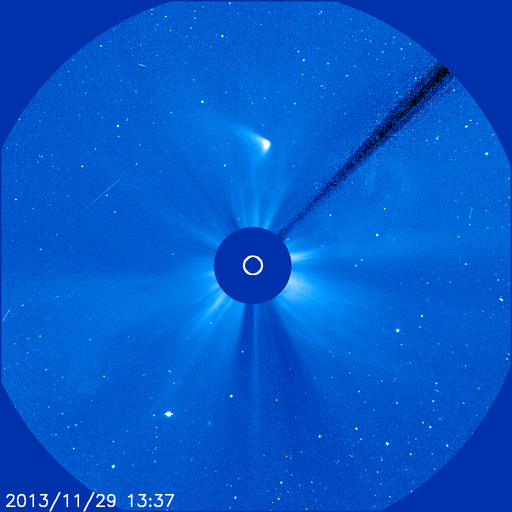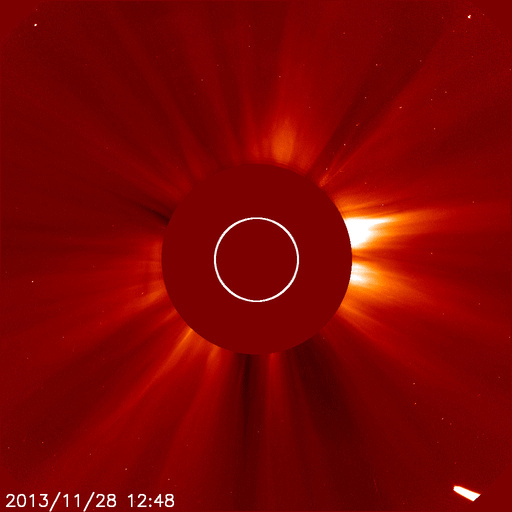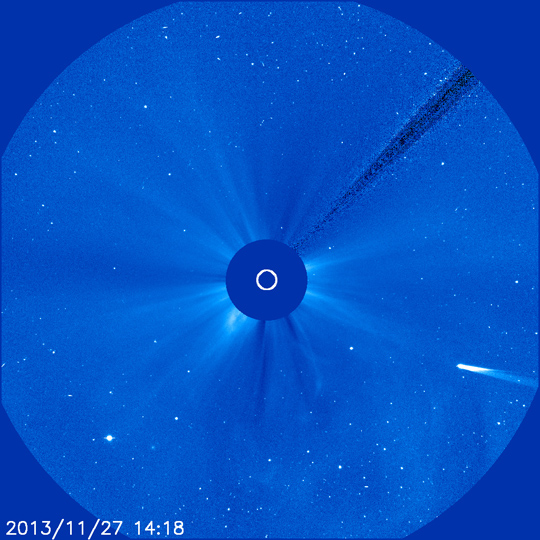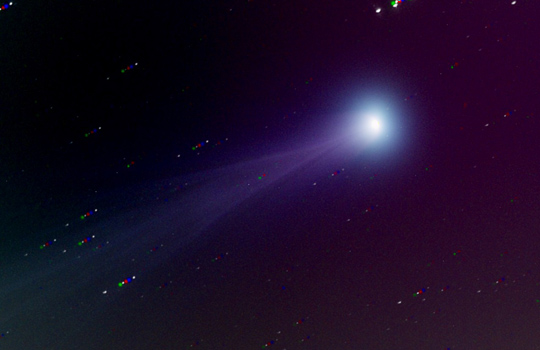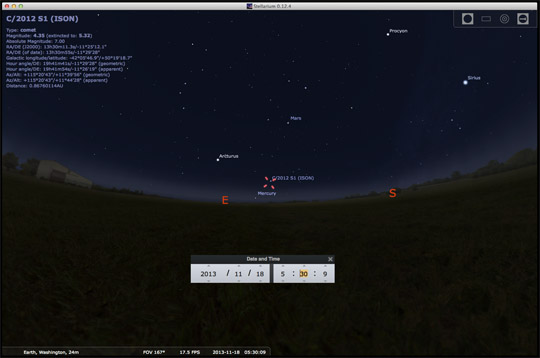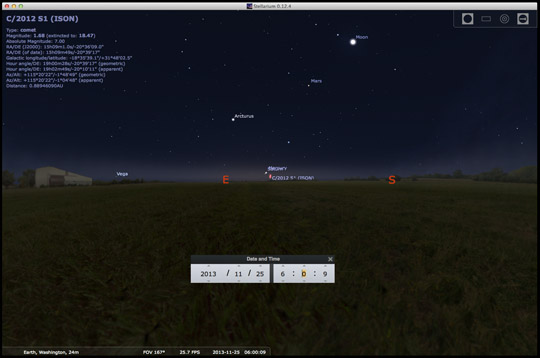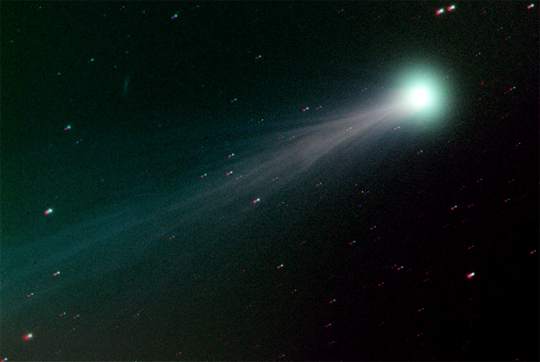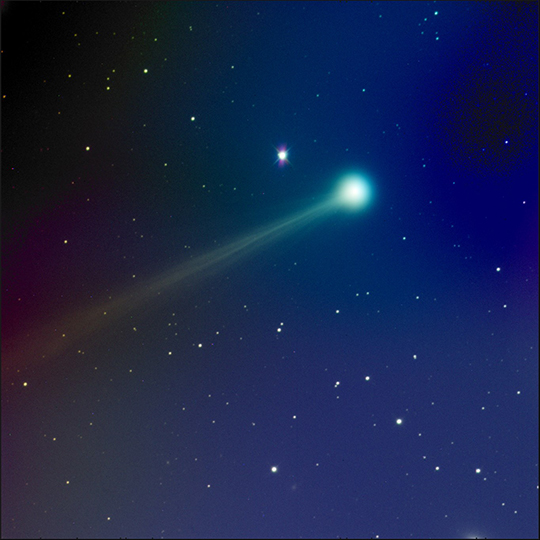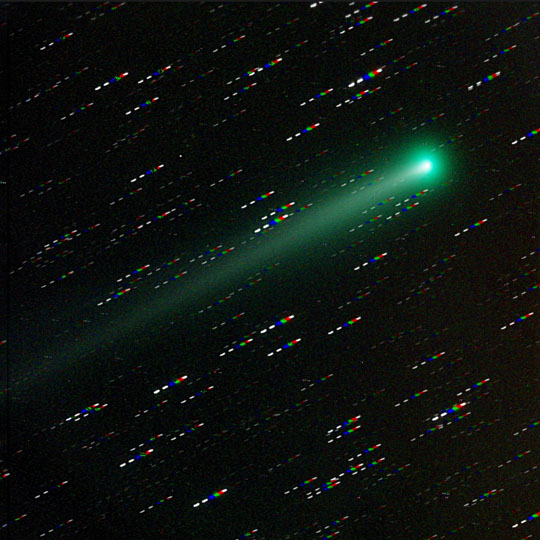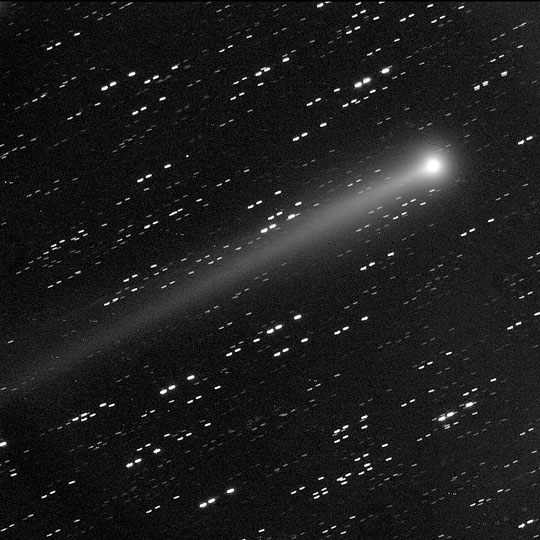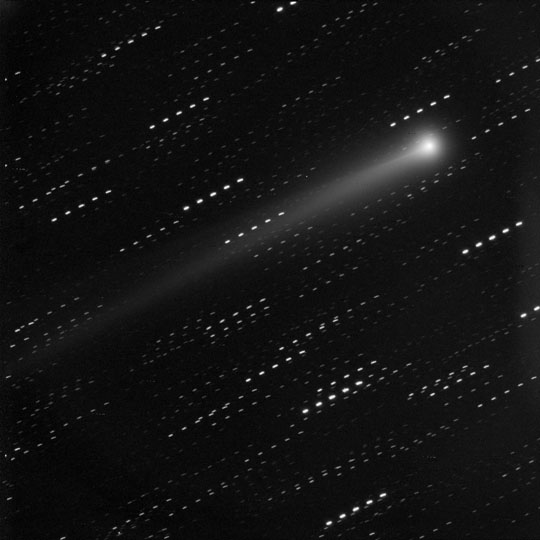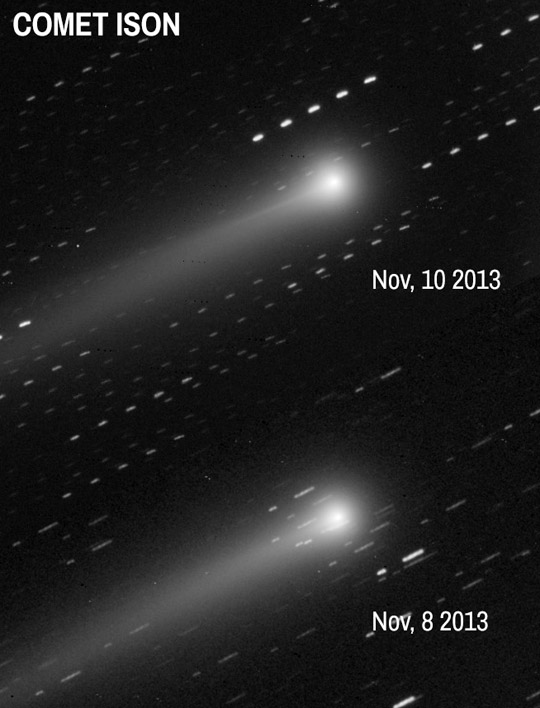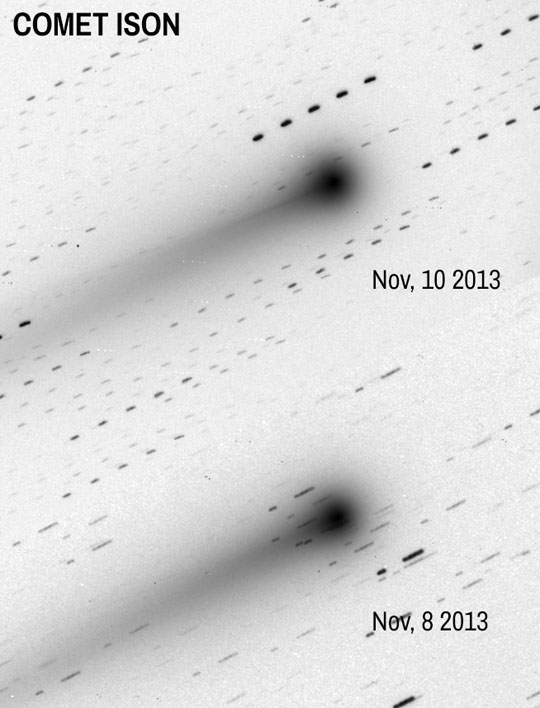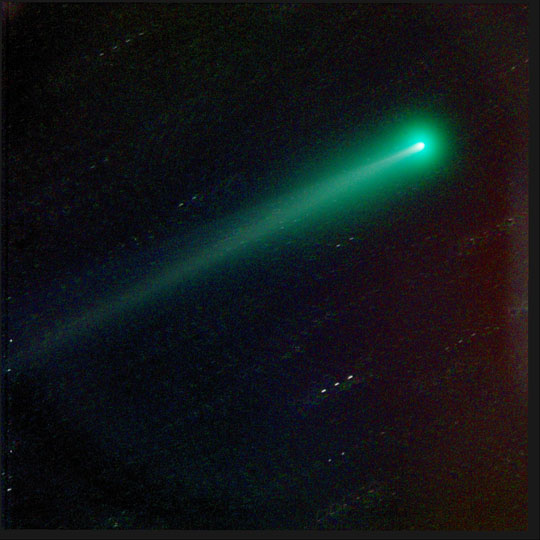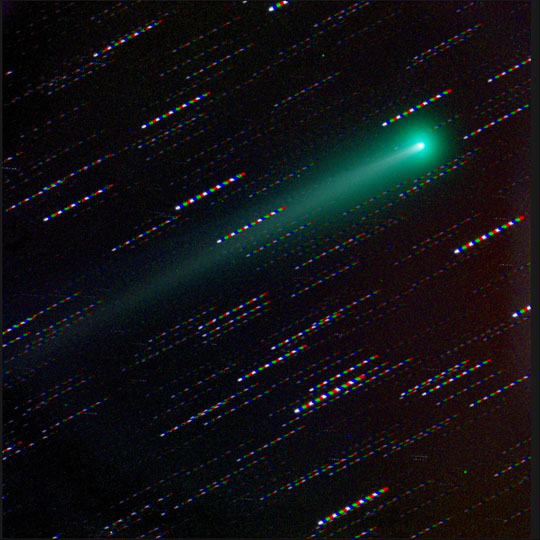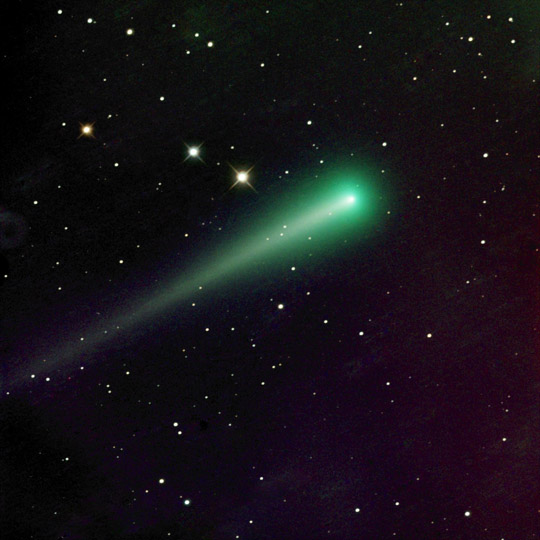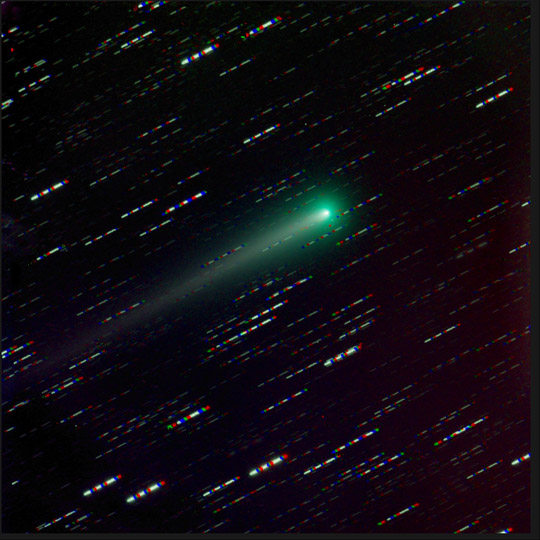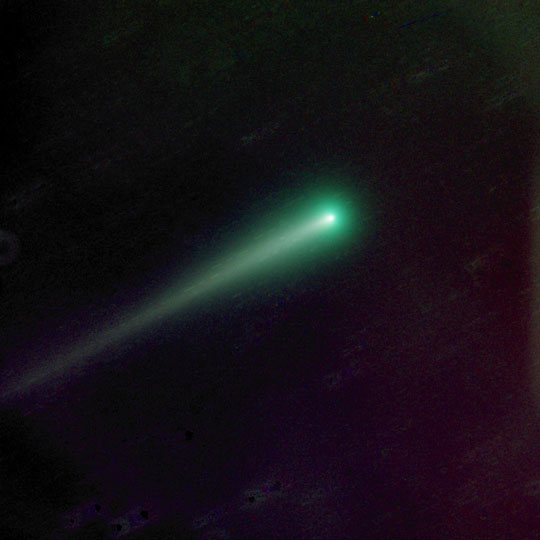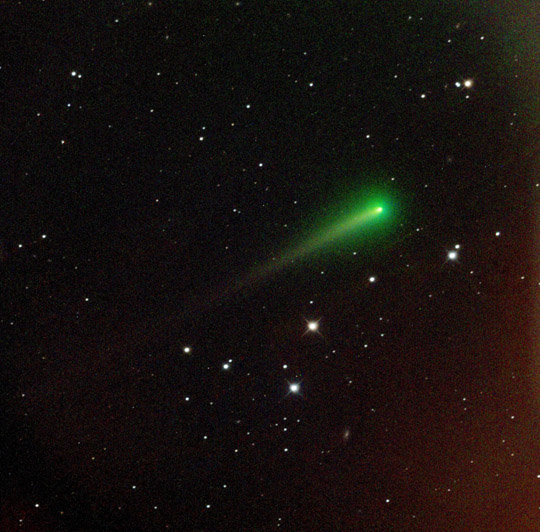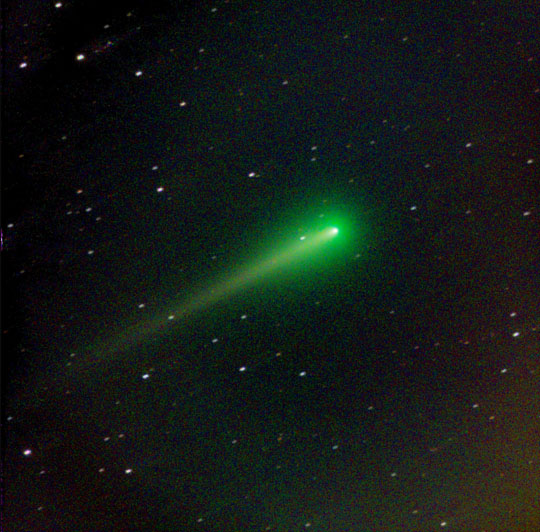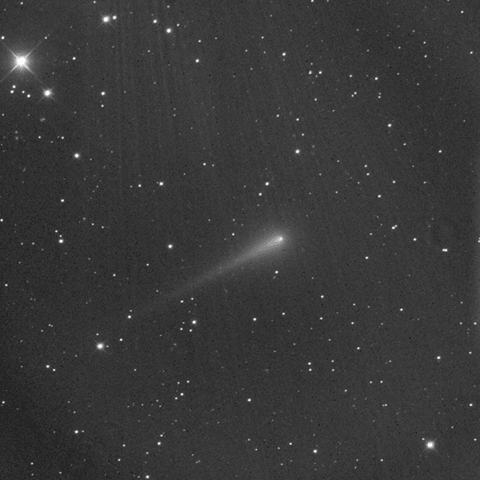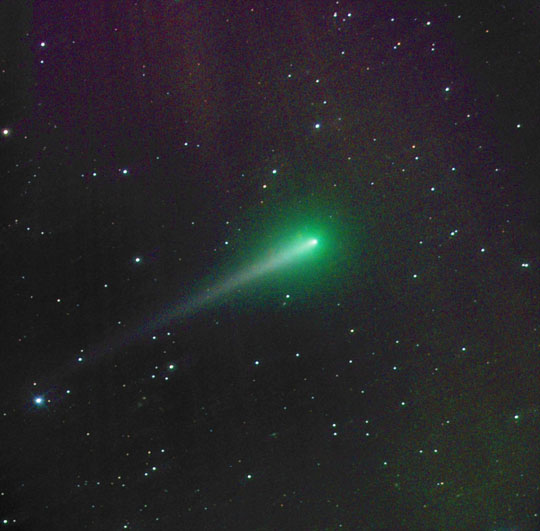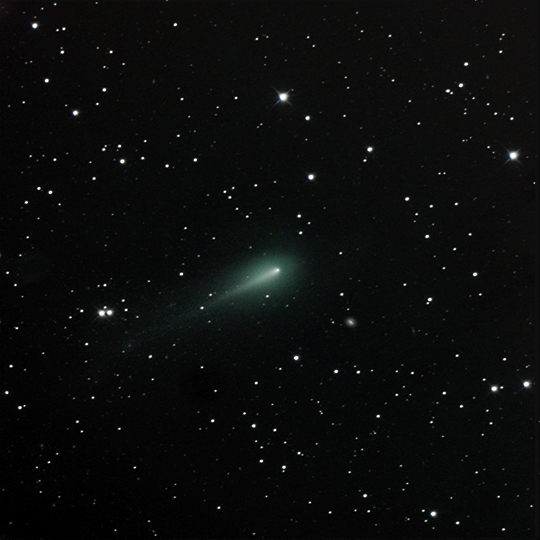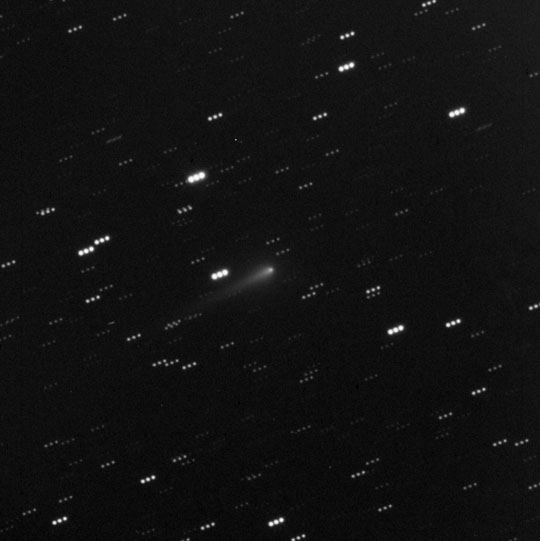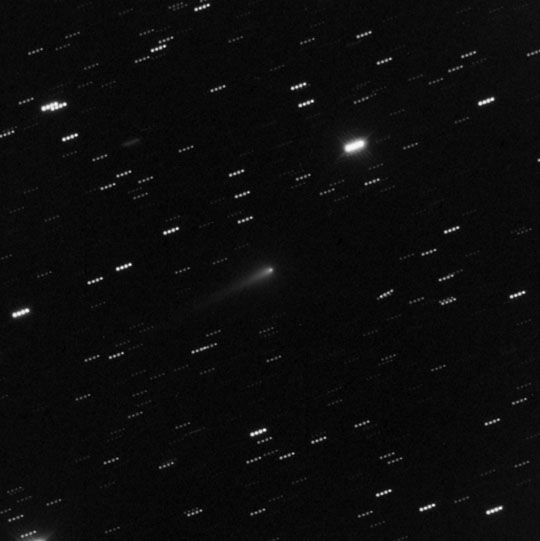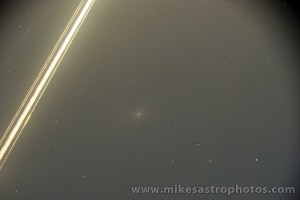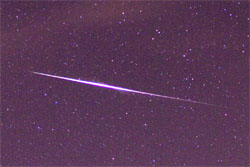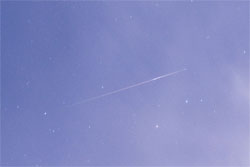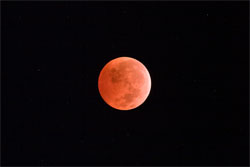Tag: Comet ISON
Latest ISON Photos
by Mike Hankey, under Comets & Meteors
Here’s the latest photo from SOHO today:
It looks like the comet has started producing a new tail.
Comet ISON Survived
by Mike Hankey, under Comets & Meteors
Contrary to the initial reports that suggested ISON died a fiery death as it plunged into the sun, ‘something’ emerged from the sun later than planned. A dust trail without a nucleus was the first suggestion. Now it appears the dust cloud is starting to get brighter. Check out this animation from the LASCO space telescope showing ISON go around the sun.
Here are the frames used to make this animation of comet ISON.
Comet ISON Today
by Mike Hankey, under Comets & Meteors
Here’s a photo from NASA’s SOHO spacecraft. Comet ISON just entered its field of view today. The space ship should be able to watch the show as the comet goes around the sun tomorrow!
Reprocessed Comet ISON Photo
by Mike Hankey, under Comets & Meteors
Here’s a reprocessed version of my comet ISON photo from Nov 15th, right around the time of the outburst. This image uses the Luminance channel. It was a bit of work to stack it all together, and it changes the color, increases the resolution but also dims some of the finer features. I think I like the original one better, but since the clouds on both coasts have kept me from imaging I figured I’d work with the data I already collected.
This photo is the result of 3×60 seconds exposures, one each through red, green and blue filters and 3×60 seconds of luminance or clear filter shots.
For more photos of comet ISON, check out my comet ISON images page.
Looking for ISON in November 2013
by Mike Hankey, under Comets & Meteors
Due to clouds and high humidity I have not been able to observe Comet ISON the last two days. The window of opportunity to catch ISON in darkness from my California observatory, while the comet is still above the 15 degree viewing threshold, is almost over. I might have 1 or 2 days left at best. Moving forward my efforts will be focused on DSLR photography of comet ISON. For the next week or so of November, ISON will be visible right before dawn on the horizon in the south east. We will then have to take a break while the comet goes around the sun. At this point the comet will only be viewable by NASA and ESA space based telescopes, but don’t worry several of them will be pointed at ISON while it grazes the sun. At some point in December, if the comet survives passage around the sun, we will start to be able to see it again in the western sky at and after dusk. If this happens it will be a spectacular sight potentially stretching across half of the sky.
Here is some information to help you observe comet ISON in November and December 2013. These ISON sky charts were created using the program Stellarium. Stellarium is a free planetarium software program that you can use to model the sky and solar system at your location. You will have to follow some special instructions to get comet ISON to show up in Stellarium. For power users, I have posted this information below.
Where is Comet ISON in November 2013 and what time will Comet ISON be visible in November 2013?
Most people interested in Comet ISON want to know where it is, what time it will be there, if they will be able to see it with their naked eye and what it will look like. Over the next week these ISON sky charts will help you find the comet while it is still visible in November.
This (Nov 18-Nov 25) is the last week to watch ISON before it passes the Sun! these ISON sky charts will help you over the next 6 weeks. To find it look in the East at 5:30 AM.
On Monday, November 18th, 2013 the comet will be visible low in the eastern sky by 5:30 am. The best viewing time for comet ISON this week will be between 5:30 – 6:00 AM. Here is a sky chart with Comet ISON for reference.
By the following Monday, November 25th, 2013, we will no longer be able to see ISON because it will be rising with the Sun. At this point we will have to eagerly wait to see what happens. I am thankful NASA has space telescopes that will watch ISON as it orbits the Sun.
How to show Comet ISON inside Stellarium?
The best way to plan out your Comet ISON observing session is the the planetarium program Stellarium. Once you download and install it, to add Comet ISON, follow these instructions:
- Press the ‘Configuration Window’ button on the left
- Press ‘Plugins’ Tab
- Press ‘Solar System Editor’
- Press ‘Configure’ Button
- Press ‘Import Orbital Elements in MPC Format’
- Press ‘Add Objects’ Button
- Select ‘Comets’ Radio Button, then ‘MPC’s list of observable comets’, then press ‘Get Orbital Elements’ Button.
- In the add objects search box enter ‘C/2012 S1 (ISON)’, select the check box and press the ‘Add Objects’ Button.
- Now you will be able to search for ISON, see where it is inside stellarium for your location, and change the viewing data and time.
This is certainly the BEST way to know how to find ISON in the sky. Good luck and happy observing!
Comet ISON Still Shining
by Mike Hankey, under Comets & Meteors
Capturing ISON was challenging again this morning, but I was able to sneak out one short exposure (1 x 60 seconds x RGB) in between clouds. It looks like it has changed again since yesterday.
ISON Really Bright Today!
by Mike Hankey, under Comets & Meteors
What a surprise it was to image ISON this morning. I immediately noticed a significant brightness. I only had about 20 minutes of image time due to the sun rising and ISON’s current low elevation. This may be the last telescope photo of ISON I take before it goes around the sun. This image is only a 60 second exposure of RGB. The clouds ruined the viewing for most of the morning and this was the first and only set of frames I could get. Feeling lucky ![]()
Here is an alert email from Mike Kelly about ISON brightening this morning.
Dear Comet ISON Observers,
There are several reports of a dramatic increase in comet ISON’s
brightness this morning. Total magnitude estimates, reported to the
Yahoo Comets Mailing List, are around 6.5 to 6.0.
Emmanuel Jehin (TRAPPIST) reports a factor of 8 increase in OH and
Afrho (dust) in the last 24 hours. He also reports that there is not
yet an indication of disruption.
A nice set of images by Juanjo Gonzalez can be found at
http://cieloprofundo.files.wor
are taken the 12th and 14th of November.
Observations are clearly need to determine how long this trend
persists, if any fragments appear, or the nucleus disintegrates. If
ISON is undergoing a fragmentation or disruption phase, expect another
ISON Alert!
Best,
Mike Kelley
Comet ISON Photos
by Mike Hankey, under Comets & Meteors
I was eager to look at Comet ISON images this morning, but a little disappointed with the second tail as it actually seems fainter in today’s pictures than it did yesterday. I think this is most likely due to differences in seeing conditions between the two days (maybe a little hazier for me today). Either way here are my latest ISON photos from this morning. Here is a page with all of my Comet ISON photos.
Here is just the luminance channel. You can see the second tail a little more clearly in the black and white photo.
Image details: 15 minute luminance channel (5×180) and 3 minute RGB. (1×180) at 3×3 binning.
For more Comet ISON photos going back to September 2013 visit my Comet ISON Photo page.
Comet ISON – New Tail Feature?
by Mike Hankey, under Comets & Meteors
I noticed a new prominent feature in the tail of Comet ISON while imaging it this morning. It looks like a thin jet towards the top.
Below is a comparison of today’s image with the last one I took just two days ago on November 8th. You can see the trail is just barely visible on the 8th.
Here is an inverted version of the same picture. Its a little easier to see the features in the inverted picture.
Here’s the color version of just the comet this morning.
And here is the color stacked with trailing stars. (I will come back another morning to image the star field and complete the final picture).
These images are the result of 5×3 minute exposures of Red, Green, Blue and Luminance at 3×3 binning on the morning of November 10th, 2013.
If you have noticed this feature already, please email me links to your most recent images. I’d love to compare. ![]()
Comet ISON Observations
by Mike Hankey, under Comets & Meteors
I’ve been diligently imaging Comet ISON each morning possible since mid September. It is changing nearly everyday, getting bigger brighter and a longer. Comets in general are challenging to image and each one has its own little quirks: how bright it is, how fast its moving, how much dark time there is available to image. For ISON we have only had about 1 hour each morning to image which doesn’t leave a lot of time for a long exposure. On a whim, I decided to combine 3 days worth of data together to get a better image. Here is a picture of Comet ISON that was taken over a three day period, November 2nd, 3rd and 8th.
Image processing is a big part of the challenge with getting a nice comet image. There are several different ways to process and look at the picture. The easiest thing to do is to just stack on the comet and have the stars trail like this image below.
While you can get a good view of the comet, the background doesn’t look so nice. We see trails of red, green, blue and white because the telescope is tracking the comet with each exposure. When we combine the image centering on the comet, the stars don’t line up in the same place, leaving us with streaked multi-colored stars.
Its a time consuming process, but what you need to do is reject all of the stars out of the pictures while stacking the RGBL frames. This will give you an image of just the comet with no stars.
Once you have the comet isolated, you then stack just the stars or re-image the star background on another day (when the comet isn’t there). Then merge the 2 images (the comet only and the starfield) using the photoshop overlay feature and you will have a nice combination of a clear starfield and a well defined comet.
Image Details for Comet ISON
Shot With 30 minutes of RGB and 1 hour of LUM
Total exposure: 2.5 hours
Camera: Apogee U16M
Guider: SBIG 402 with MMOAG Off Axis Guider
Telescope: RCOS 14.5
Mount: Paramount ME
Location: Auberry, CA
Date: November 2nd, 3rd & 8th
Software: The SkyX, MaximDL, FocusMax, CCDAutoPilot, CCDStack, Photoshop
Comet ISON Color
by Mike Hankey, under Comets & Meteors
The current Moon phase is making it difficult to image, but Comet ISON continues to get brighter. Here’s a color picture of ISON from October 26th, 2013.
Comet ISON in Mars Light
by Mike Hankey, under Comets & Meteors
The early morning moon has been hampering ISON imaging the last few days and this morning we had a little competition from our friend Mars. Here’s an animation of 9 frames of Comet ISON passing just two degrees from the Mars. The light streaks in the picture are Martian light.
Here’s a color RGBL image from the same morning. Between the Moon and Mars its a pretty grainy picture, but I kinda of like the planetary glow in the shot.
Comet ISON Getting Stronger
by Mike Hankey, under Comets & Meteors
Here’s a photo of Comet ISON from October 5th, 2013. Some new studies have been published this week that seem to be improving the chances of ISON’s survival around the Sun on Thanksgiving day. If that happens we should have quite a light show leading up to the new year.
This photo was constructed using 30 minutes of Luminance and 2 minutes each of Red Green and Blue.
For more info about comet ISON’s survival rates check out this article from Sky and Telescope.
Early Views of Comet ISON
by Mike Hankey, under Comets & Meteors
Here are two photos of Comet ISON from September 24th and 26th.
Here is comet from two days before. The tail and comet appear brighter after just two days, but its possible this could just be differences in the seeing conditions between the two days.
